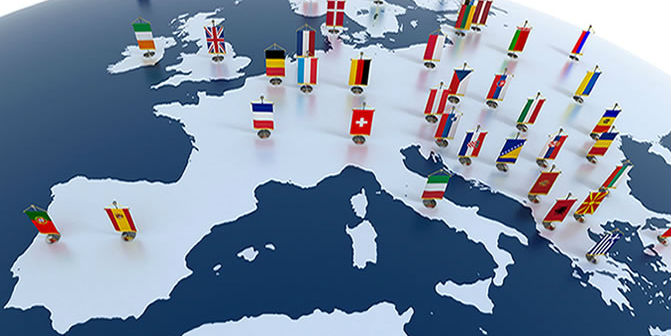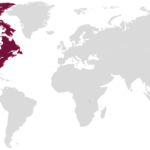Direct Link / PostNord has been studying the European e-commerce market in the E-commerce in Europe report since 2014. Obviously, over the years, there has been quite a lot of changes when it comes to consumer behavior and preferences that has been interesting to study.
The report is based on interviews with just over 12 000 consumers in Belgium, Denmark, Finland, France, Germany, Italy, the Netherlands, Norway, Poland, Spain, Sweden and the UK. E-commerce is defined as the purchase of physical products online.

The Big two continue to dominate European E-commerce
E-commerce in Europe has grown during the year. Average sales per person per month amount to EUR 161 in the twelwe countries surveyed. As in earlier reports, Germany and the UK ar by far the strongest e-commerce markets in Europe. Combined with a large population, both markets have relatively high purchase amounts and a high e-commerce share. 62 million consumers in Germany have shopped online during the last year, while the same figure for the UK is a bit over 49 million. At the other end, countries like Italy, Spain and Poland show relatively low average purchases. At the same time, these three markets are now in strong growth from previously quite low levels.
Top twelve product categories
When it comes to the most popular product categories among European shoppers the top three, Clothing and Footwear, Home Electronics and Books/audiobooks has stayed the same for a number of years. Clothing and Footwear is the most bought product category in all of the surveyed markets except for one; Sweden stands out here with Pharmacy products comin in as the most popular product bought online. Pharmacy products belong to the group of runner-up categories that we have been able to see gaining momentum in recent years, as also for example Cosmetics, Groceries and Home Furnishing.

Pandemic-driven growth in European e-commerce – but will it last?
E-commerce is growing rapidly in virtually all European countries. In 2020 we could see a growth of up to 40 percent in some markets, among them Sweden and Poland. This exceptional growth rate was, of course, largely driven by the pandemic. Consumers in all of the twelwe markets studied state that they have been making more online purchases during the pandemic. Online shoppers in Spain, the UK and Italy has increased their purchases the most. Spain and Italy are markets that have historically had a lower level of e-commerce, so it is not very surprising that more people have changed their behavior in these countries. The UK also shows high numbers. Nor is it particularly surprising given the severe shut-downs that have taken place there. Overall, it is in particular younger consumers who state that they have been shopping online more than before.
However, purchases from foreign websites declined marginally compared to last year´s report, due to delivery problems and societies being shut down. Cross-border purchases are expected to increase gradually as pandemic-related problems diminish in scope. According to this year´s survey, 216 million has made cross-border purchases compared to 220 million in last years´survey. China, the UK, US and Germany was the most popular countries to make purchases from.
In this years survey we also asked the respondents if they thought that they would increase or decrease their online shopping after the pandemic, compared to the current situation. Thera are differences between countries in this respect. A majority in the quite mature online markets Germany, the Netherlands and Belgium make the assessement that they will decrease their level of online shopping, while the opposite is the case in the growing markets of Spain, Italy and Poland.

Varied interest in paying for sustainable deliveries
Italy and Germany are the countries in which the highest proportion of e-commerce consumers would be willing to pay extra for a more sustainable e-commerce delivery. It is mainly in the younger consumer category (18-29 years) that online shoppers are willing to pay more for this. However, these respondents also consider themselves to be more or less equally willing to pay for faster deliveries. Thus, it may be that the willingness to pay for more tailored deliveries is generally higher in these groups. There is least interest in Finland and Poland. This could be due to the fact that consumers here consider the existing delivery
options to be good from an environmental perspective. Also, both Finland and Poland ranks among the top European countries in terms of the deployment of parcel machines, which can be viewed as a more eco-friendly option than home delivery.
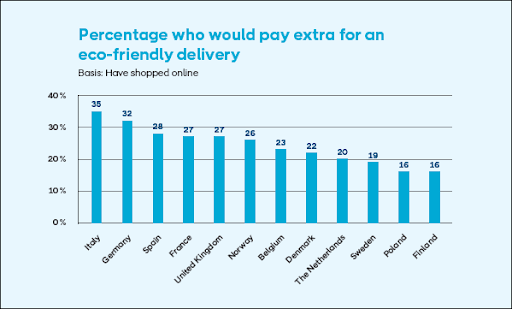
Shop online locally for environmental reasons?
Online consumers can have different reasons to shop within their own country. One of those reasons that we have been measuring in previous reports is language barriers. However, even in the area of sustainability, there are consumers who consciously by domestically in an effort to reduce transport distances and carbon emission. There are consumers in all of the surveyed markets who state that they have chosen to but domestically for environmental reasons, but online shoppers in Spain and Italy are at the top followed by consumers in France.
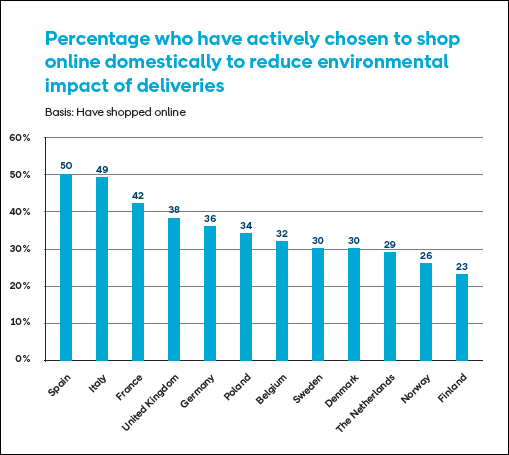
Faster deliveries have become more important during the pandemic
E-commerce sales has increased across the board during the pandemic and so has the number of consignements. Online shoppers in general are ordering a higher number of products they have need for in everyday life. As a result , consumers in many countries expect faster deliveries. In the UK, for example, 15 percent expect a delivery time of 1-2 days, compared to 10 percent last year. In Belgium, the corresponding figure is 18 percent compared to 11 percent last year. This may be related to the fact that a lot of new consumers, especially older ones, arrived in the early stages of the pandemic and have now become accustomed to e-commerce, with increased demands as a result.
It´s also interesting to see in what way the online consumers in the different surveyed markets prefers to have their purchases delivered. In not less than nine of the studied countries, “Home delivery with signature requirement” is the most preferred delivery alternative. In for instance Spain, 70 percent of the online consumers prefers this method.
The second most preferred choice is “Home delivery or delivery outside the door without signature requirement”. In Sweden and Norway “Delivered to my mailbox” by the mail carrier is the most preferred delivery method. Finland is the country that really stands out in this regard since Finnish online consumers hold “Collect the product myself from a parcel machine” as their number one preference. Also Polish consumers has a high preference here as this alternative comes in as number two. Admittetly, both Finland and Poland have been early in placing a fairly large number of parcel machines. But it is still intresting to note the differences between these two and the larger e-commerce markets like the UK and Germany where this method of delivery is of very low popularity.
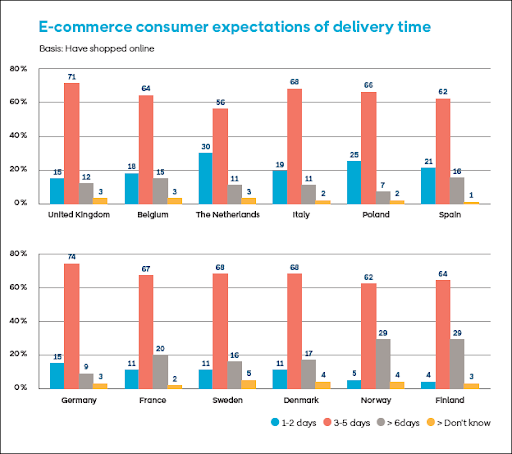
Spotlight on the two dominating e-commerce markets in Europe – Germany and the UK
Germany is at the forefront of e-commerce. The market is mature and well developed compared to most of the rest of Europe. The proportion of internet users is 96 percent, which is reflected in the Germans high level of e-commerce. In the survey, 94 percent of Germans state they have shopped online.

Impact of the corona-virus pandemic
German e-commerce has been thriving in recent years. And the pandemic has boosted online shopping even more. The increasing volumes of parcels in circulation has presented some logistical challenges. Logistics company DHL has decided to expand its distribution center in Aschheim. The distribution center will be the largest in Germany with capability to sort up to 72 000 parcels per hour.
International marketplaces
Amazon, which entered the German market already in 1998, is still by far the most popular marketplace to shop from, followed by eBay and Zalando.
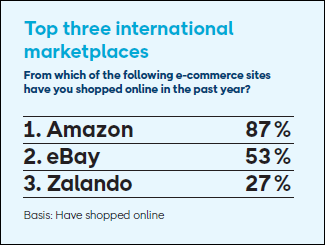
Most commonly products bought online
Clothing and footwear is still the most commonly product to buy. A change from last years survey is that pharmacy products is now in second place, before Home electronics and Books and media.
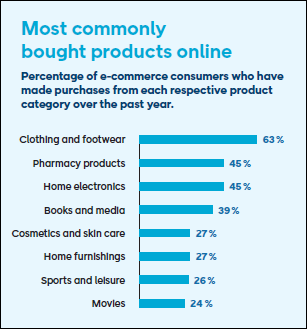
The United Kingdom is undoubtedly one of the world´s leading e-commerce nations. They have the highest online share of total retail sales in Europe, which is partly explained by the fact that UK online shoppers were particurlarly early in buying groceries online. Internet penetration is 98 percent, making the UK one of the top EU countries for internet usage. In March 2021 e-commerce accounted for 34% of all retail sales.

Impact of the corona-virus pandemic
The UK has been under a series of lockdowns during the pandemic. Few open physical stores more or less forced the Britons to turn to e-commerce. As much as 40 percent of consumers state they have shopped more during the pandemic, and that in a country where the population already does a large amount of their shopping online.
International marketplaces
As in Germany, Amazon established in the UK in 1998. They have a clear top position with 87 percent of the UK online consumers stating they shopped on Amazon. They are followed by the marketplaces eBay and Etsy.
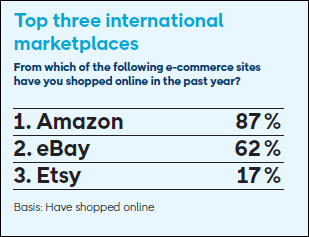
Most commonly products bought online
The UK is the only country in the survey where groceries ranks as high as number two
when it comes to most purchased product categories, after Clothing and footwear. As many as 46 percent of consumers state that they shop for food online. Books and media check in at third place followed by Cosmetics and skin care.
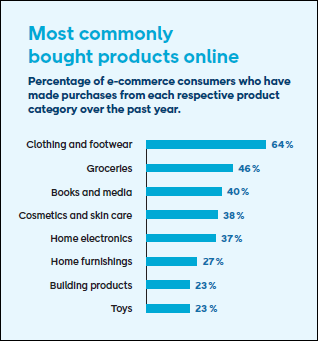
Direct Link create borderless e-commerce solutions for global delivery. We are specialists in customer – specific delivery solutions and the distribution of e-commerce goods to anywhere in the world. We know the people, the systems, and the ways between. Direct Link is a fully owned subsidiary of PostNord, the Swedish and Danish national post service.

The author of the article, Olof Källgren, is Market Information Manager at Direct Link, and has been working with the e-commerce within Direct Link for the past ten years.

